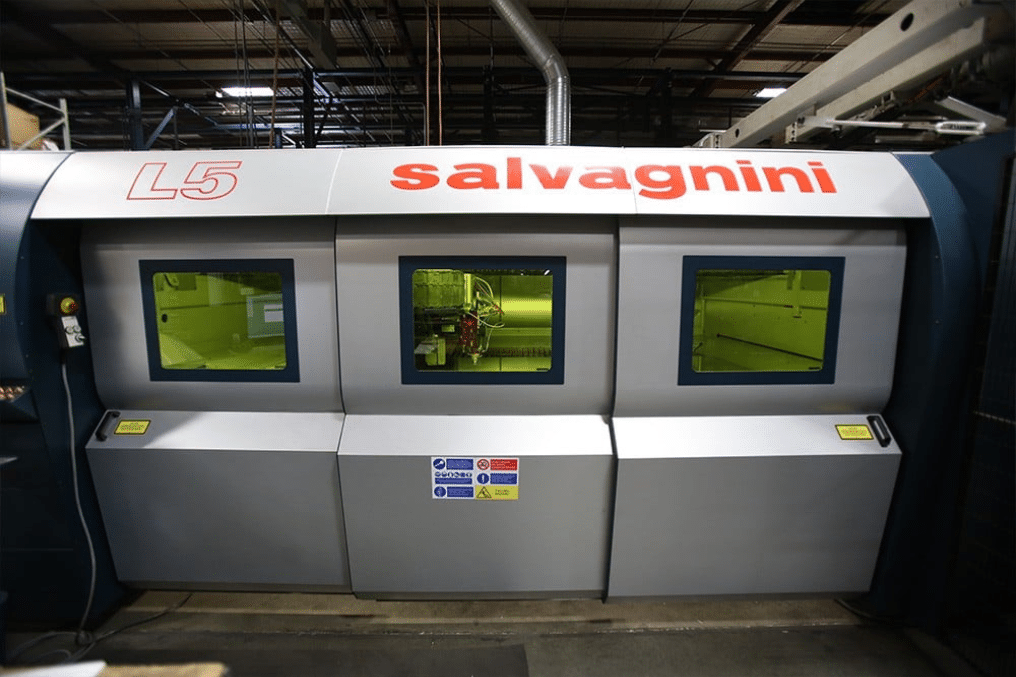Laser-cutting technology has revolutionized the manufacturing industry, providing unparalleled precision and efficiency in cutting a wide range of materials in sheet metal manufacturing. One such material that has gained popularity in recent years is vinyl-coated stainless steel. This unique product combines the durability and strength of stainless steel with the versatility and aesthetics of vinyl coatings.
However, laser cutting vinyl-coated stainless steel presents unique challenges when compared to cutting regular stainless steel.
Common Challenges with Laser Cutting Stainless Steel
The primary issues of laser cutting stainless steel include heat-induced material warping and discoloration, which can compromise the structural integrity and aesthetics of the final product. With proper laser system calibration, cooling mechanisms, and cutting techniques, manufacturers can achieve high-quality results while minimizing the associated risks.
The same goes true for laser cutting vinyl-coated stainless steel, yet the challenge, solutions, and type of laser cutting are slightly different. Let’s dive in.
Challenges of Laser Cutting Vinyl-Coated Steel
Problem 1: Material Fusion and Damage
One of the primary concerns when laser cutting vinyl-coated stainless steel is the potential for the vinyl coating to melt or burn. The heat generated by the laser can cause the vinyl coating to fuse to the stainless steel, resulting in an uneven surface and reduced aesthetic appeal. Additionally, the high temperatures can cause the stainless steel itself to warp or become discolored.
Solution: Careful Calibration and Cooling
To minimize the risk of material fusion and damage, it is crucial to calibrate the laser cutter’s settings carefully. By adjusting the cutting speed, power, and frequency, operators can achieve a balance that prevents the vinyl coating from melting or burning while still cutting through the stainless steel efficiently. Additionally, incorporating a cooling system, such as air or water-assisted cooling, can help to dissipate heat and protect both the vinyl coating and the stainless steel substrate.
Problem 2: Toxic Fumes and Emissions
Vinyl, also known as PVC (polyvinyl chloride), releases toxic fumes when exposed to high temperatures, such as during laser cutting. The fumes can pose health risks to operators and can be harmful to the environment if not properly managed. Additionally, the release of toxic fumes can cause the vinyl coating to degrade, compromising the final product’s quality and appearance.
Solution: Ventilation and Filtration Systems
To address the issue of toxic fumes, it is essential to have a well-designed ventilation and filtration system in place. This system should effectively capture and filter the fumes, ensuring that they are not released into the surrounding environment or inhaled by operators. Some laser-cutting machines are equipped with built-in fume extraction systems, while others may require an external system to be installed. It is also crucial to ensure that operators are aware of the risks and follow appropriate safety protocols, such as wearing proper protective equipment.
Problem 3: Limited Laser Cutting Options
Not all laser cutting service providers have the necessary equipment or expertise to handle vinyl-coated stainless steel products. This can potentially increase lead times for these specialized products.
Solution: Research and Collaboration
To overcome this challenge, it is essential to conduct thorough research to identify experienced and reliable laser-cutting service providers with the necessary equipment and knowledge to handle vinyl-coated stainless steel products. Additionally, an outsourced partner with advanced equipment, such as an automated fabrication cell that includes laser cutting, can bring additional efficiencies and quality to your product.
Estes Revolutionary Fiber Laser Efficiently Cuts Vinyl-Coated Stainless Steel
Estes’ fiber laser cutting technology, the Salvagnini L5, represents a significant leap in productivity and quality in the laser cutting industry.
As with many new technologies, it was not without its own learning curve. The fiber laser cut the vinyl and stainless steel very well, but the problem was with the ability to find the right vinyl and laser program recipe that would allow the vinyl to remain adhered to the substrate while under the stresses of the high, focused pressure of the assist gas applied during the cutting process.
The resulting problems created by vinyl that came loose during the cutting cycle included cases where the bubbled vinyl would attach to the cutting head, causing stoppage and yield loss as well as wrinkled vinyl that could cause forming marks later in the process.
A cross-functional Estes team, with the support of two material suppliers, set out to identify the best vinyl and laser program recipe combination to fully harness the efficiency and quality capabilities of the machine. After testing five different vinyl materials from four different vendors utilizing five different recipe variations, Estes successfully identified a recipe that could successfully cut any of three different vinyl materials without loss of adhesion.
While laser cutting vinyl-coated stainless steel products presents a unique set of challenges, these obstacles can be overcome with careful planning, the right equipment, and, most importantly – collaboration with experienced, knowledgeable professionals who understand the complexities of cutting cosmetically critical stainless steel materials.
Estes is equipped to handle the laser cutting needs of your sheet metal fabrication project or prototype. Contact us today to get more information on how we can provide what you need.
This article, originally published in 2014, has been updated with the latest information and laser technologies.









